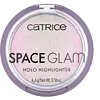What's inside
What's inside
 Key Ingredients
Key Ingredients

 Benefits
Benefits

 Concerns
Concerns

 Ingredients Side-by-side
Ingredients Side-by-side

Synthetic Fluorphlogopite
CI 77891
Cosmetic ColorantDimethicone
EmollientHdi/Trimethylol Hexyllactone Crosspolymer
Boron Nitride
AbsorbentPEG-12 Dimethicone
Skin ConditioningVinyldimethicone
Calcium Titanium Borosilicate
AbrasiveMica
Cosmetic ColorantCaprylyl Glycol
EmollientPotassium Chloride
Ethylhexylglycerin
Skin ConditioningChlorphenesin
AntimicrobialCI 77491
Cosmetic ColorantChondrus Crispus
MaskingOctyldodecyl Stearoyl Stearate
EmollientTocopheryl Acetate
AntioxidantWater
Skin ConditioningTriethoxycaprylylsilane
Tin Oxide
AbrasivePEG-26-PPG-30 Phosphate
CleansingSilica
AbrasiveCI 77492
Cosmetic ColorantGellan Gum
Tocopherol
AntioxidantSynthetic Fluorphlogopite, CI 77891, Dimethicone, Hdi/Trimethylol Hexyllactone Crosspolymer, Boron Nitride, PEG-12 Dimethicone, Vinyldimethicone, Calcium Titanium Borosilicate, Mica, Caprylyl Glycol, Potassium Chloride, Ethylhexylglycerin, Chlorphenesin, CI 77491, Chondrus Crispus, Octyldodecyl Stearoyl Stearate, Tocopheryl Acetate, Water, Triethoxycaprylylsilane, Tin Oxide, PEG-26-PPG-30 Phosphate, Silica, CI 77492, Gellan Gum, Tocopherol
Talc
AbrasiveMica
Cosmetic ColorantSilica
AbrasiveDiisostearyl Malate
EmollientZea Mays Starch
AbsorbentOctyldodecanol
EmollientBis-Diglyceryl Polyacyladipate-2
EmollientDimethicone
EmollientIsononyl Isononanoate
EmollientSynthetic Fluorphlogopite
Polyisobutene
Jojoba Esters
EmollientTocopheryl Acetate
AntioxidantEthylhexylglycerin
Skin ConditioningPhenoxyethanol
PreservativeTin Oxide
AbrasiveCI 77891
Cosmetic Colorant
 Reviews
Reviews

Ingredients Explained
These ingredients are found in both products.
Ingredients higher up in an ingredient list are typically present in a larger amount.
Ci 77891 is a white pigment from Titanium dioxide. It is naturally found in minerals such as rutile and ilmenite.
It's main function is to add a white color to cosmetics. It can also be mixed with other colors to create different shades.
Ci 77891 is commonly found in sunscreens due to its ability to block UV rays.
Learn more about CI 77891Dimethicone is a type of synthetic silicone created from natural materials such as quartz.
What it does:
Dimethicone comes in different viscosities:
Depending on the viscosity, dimethicone has different properties.
Ingredients lists don't always show which type is used, so we recommend reaching out to the brand if you have questions about the viscosity.
This ingredient is unlikely to cause irritation because it does not get absorbed into skin. However, people with silicone allergies should be careful about using this ingredient.
Note: Dimethicone may contribute to pilling. This is because it is not oil or water soluble, so pilling may occur when layered with products. When mixed with heavy oils in a formula, the outcome is also quite greasy.
Learn more about DimethiconeEthylhexylglycerin (we can't pronounce this either) is commonly used as a preservative and skin softener. It is derived from glyceryl.
You might see Ethylhexylglycerin often paired with other preservatives such as phenoxyethanol. Ethylhexylglycerin has been found to increase the effectiveness of these other preservatives.
Mica is a naturally occurring mineral used to add shimmer and color in cosmetics. It can also help improve the texture of a product or give it an opaque, white/silver color.
Serecite is the name for very fine but ragged grains of mica.
This ingredient is often coated with metal oxides like titanium dioxide. Trace amounts of heavy metals may be found in mica, but these metals are not harmful in our personal products.
Mica has been used since prehistoric times throughout the world. Ancient Egyptian, Indian, Greek, Roman, Aztec, and Chinese civilizations have used mica.
Learn more about MicaSilica, also known as silicon dioxide, is a naturally occurring mineral. It is used as a fine, spherical, and porous powder in cosmetics.
Though it has exfoliant properties, the function of silica varies depending on the product.
The unique structure of silica enhances the spreadability and adds smoothness, making it a great texture enhancer.
It is also used as an active carrier, emulsifier, and mattifier due to its ability to absorb excess oil.
In some products, tiny microneedles called spicules are made from silica or hydrolyzed sponge. When you rub them in, they lightly polish away dead skin layers and enhance the penetration of active ingredients.
Learn more about SilicaSynthetic Fluorphlogopite is the synthethic version of mica. It consists of fluorine, aluminum and silicate.
Synthetic Fluorphlogopite is used to add volume to products.
It is considered non-irritating on the skin.
Learn more about Synthetic FluorphlogopiteTin Oxide is an inorganic oxide used to add opacity and volume to a product. In nature, it is already found in mineral form. The main ore of tin is an opaque and shiny mineral called casseterite.
Tin Oxide helps remove translucency in a product, or make it more opaque. Besides adding opacity, tin oxide is used for bulking to add volume.
Tocopheryl Acetate is AKA Vitamin E. It is an antioxidant and protects your skin from free radicals. Free radicals damage the skin by breaking down collagen.
One study found using Tocopheryl Acetate with Vitamin C decreased the number of sunburned cells.
Tocopheryl Acetate is commonly found in both skincare and dietary supplements.
Learn more about Tocopheryl Acetate